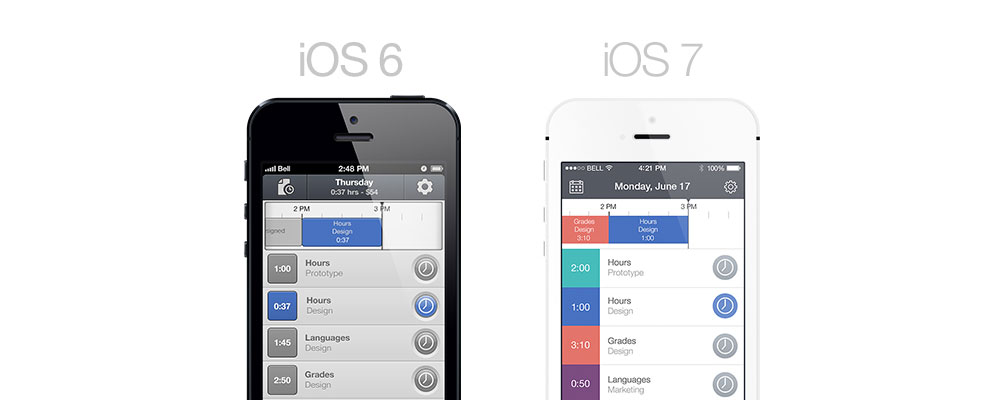Many designers have struggled to make the transition from iOS 6 to iOS 7. Even when they figure out how to design an app that works for iOS 7, it’s hard to still make it unique. My friend and co-author of The App Design Handbook, Jeremy Olson, wrote this post when iOS 7 was announced earlier this year. I think there is still plenty we can learn from it.
Enter Jeremy
iOS 7…
Some of it looked incredible. The parallax effects, zooming user interfaces, and advanced physics got me excited about the possibilities for new, unexplored user interface ideas.
But man, those icons…
Borderless buttons!?
I understood the move away from leather stitching but wow, now realistic ornaments are suddenly of no value whatsoever?
Like many designers, my reaction to iOS 7 went something like this:

Via Hossam Hassan
But we’ve all had an earful from whining designers so I won’t go down that path. I promised myself that I wouldn’t judge the UI until I’ve spent at least a week or so using it regularly.
Despite my initial fears, I actually really enjoy using iOS 7 on a daily basis. I still have some complaints about several visual design choices but you have to remember, Apple has only been working on this for a matter of months. That’s pretty insane. I mean, it takes us at least a year to put out a single app, let alone an entire operating system!
So give them a break. I talked to a number of folks at Apple. They understand that this thing isn’t finished yet and they want our feedback (feel free to email me and I’ll pass it along). It’s only going to get better.
Now, to the pressing question…
How do we respond to iOS 7?
Answering this question may very well play a large role in the future success or failure of indies around the world over the next few years, so it’s important to talk about. Based on my conversations with folks at Apple and leaders in the app community, I’ll lay out a few thoughts.
We have work to do
- Apps built on top of the iOS 6 skeleton, with lots of gradients, bevels, and realistic details — apps like Tweetbot and Grades — look heavy and out of place in iOS 7. That’s just a fact.
- No doubt, apps that embrace Apple’s paradigm shift will have an edge over apps that don’t. Apple will more likely feature them and users will more likely download apps that fit in. Evolve or die.
- I think Marco Arment’s attitude is a good one: this is the single biggest opportunity iOS developers have had since the App Store launched. Every category is up for grabs once again.
But… as always, innovation is what matters
Just for kicks, an early mockup that completely mimics iOS7′s default design language.
- Winning apps won’t merely take Apple’s default look and mimic it. Think about how boring it would be if all of our apps looked like iOS 7 Calendar or Settings. It would get old really fast. But that’s nothing new. Think about if all the apps on iOS 6 looked like iOS 6 Calendar and settings… Yep, it would be really boring.
- Apple realizes that the diversity of styles on the App Store is one of their strong points and hopefully that won’t change on iOS 7.
- The best iOS 7 apps will take Apple’s new governing principles of clarity, depth, and deference, and interpret those principles in a unique way. They will innovate on top of the platform just like the best iOS 6 apps did.
- Designing for iOS 7 will mean much more than merely adjusting your visual style. Although I think we should try to give our apps a unique look through subtle twists on the iOS 7 design language, I’m excited to focus more on making our apps unique by experimenting with novel interaction models, transitions, and physicality, making our apps a lot more visceral. Since iOS 7 is more focused on these kinds of interactions, I think the best designs will innovate in those areas. That might mean us designer types might need to start learning a thing or two about Xcode.
- Don’t throw away all thought of metaphor and realism. Both minimal and realistic interfaces are tools in our toolbox and we need to focus on making the best experiences for our users. Fitting into the iOS 7 environment is part of that. Realistic-leaning apps on iOS 7 will be different than realistic-leaning apps on iOS 6. I don’t know how exactly but that’s something we’ll be figuring out as the platform continues to mature and users seek more unique and delightful experiences. Some people really like realistic interfaces and I don’t think they are going away forever, despite being somewhat out of style.
Redesigning Hours
Redesigning Hours has been a ton of fun. We have only just gotten started but removing visual noise has allowed us to focus on some interesting interaction issues that we hadn’t thought of before. Simplifying buttons allows us to also do some really interesting animations and transitions, making for a more visceral and fun experience.
I still like the old design and can’t say that the iOS 7 version is necessarily a huge improvement in the visual department, but thinking about the principles of iOS 7 design has sparked breakthroughs that will definitely make Hours a better app over all.
That’s exciting.
We would love to get your feedback so feel free to comment here or on Dribbble.
—-
Jeremy Olson makes a great co-author
I’m thrilled to introduce Jeremy Olson as the co-author of The App Design Handbook, iOS 7 edition. Jeremy has designed many excellent apps, but is best known for Languages, Hours, and Grades (which won an Apple Design Award in 2011). Through Tapity, his app design company, he has worked with dozens of great clients trying out the latest design principles.
Once Jeremy and I started talking about working together, I knew he was the right guy to work with. Not only because his excellent design skill and ability to teach, but also because we were born on the same day. Seriously. We don’t just share a birthday, but were born on the exact same day. I’m actually still not sure which one of us is older…
Anyway, this book is going to be wonderful thanks to Jeremy’s huge contributions.
The App Design Handbook, iOS 7 Edition: Coming November 6th
Let’s talk about some of the logistics for a few minutes. The book comes out next wednesday (November 6th). The new edition includes the entire book rewritten for iOS 7 as well as a lot of new bonus content. Including nine interviews with iOS design experts. The interviews alone are worth an entirely new edition!
We’ll add new tutorial videos as well, to walk you through updating your apps to iOS 7 and how to implement basic design principles.
If you already own The App Design Handbook you can purchase the new edition for 70% off. Seriously, that’s a huge discount based on the amount of new content. Look for a special link just for you on launch day.
Next week I’ll have more updates, sample content, and exact launch details. I can’t wait to get this book out to you! If you aren’t already on the list, sign up below.





This is a very insightful article, thanks.
For an app that my development team is building, they are not taking into consideration iOS7 design options. I honestly don’t think they know how to do this. What would you recommend I do? I definitely don’t want my app to look outdated when it’s released this month.
Can the design be done separately than the coding? I’m asking a lot and hope you don’t mind. Your article just opened my eyes..wide open. thanks guys!
Nathan